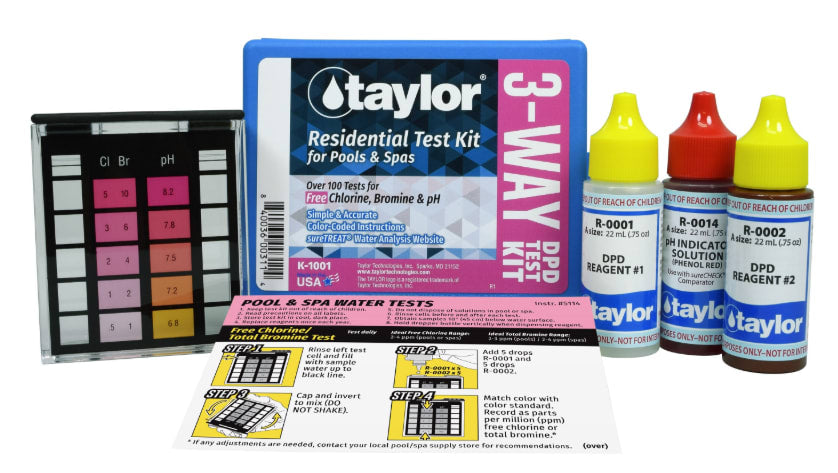Taylor 3-Way DPD Test Kit for Free Chlorine, Bromine, pH | K-1001
- Ships within 1-2 business days. FREE Shipping for orders over $100 or $9.99 flat rate to lower 48 states. Free Returns within 30 days*!
- In stock, ready to ship
- Backordered, shipping soon
Taylor® K-1001 DPD 3-Way Test Kits offer foundational testing for balanced pool and spa water using DPD as a reagent. Easy to use and designed for homeowners with straightforward instructions, K-1001 kits make water care simple and effective.
DPD is a reagent and type of testing for chlorine levels, can differentiate between Free Chlorine vs Combined Chlorine, by creating a pink color. This can differ from OTO, a yellow/orange reagent that only reacts to measure Total Chlorine only.
- Free Chlorine: Free chlorine is the active form of chlorine available to disinfect water and eliminate contaminants. Taylor Free Chlorine tests provide precise measurements to ensure adequate levels for effective sanitization.
- Bromine: For pools and spas that use bromine instead of chlorine, you can be certain there’s enough disinfectant to keep the water clean.
- pH: Taylor pH tests provide pinpoint accuracy to help ensure balanced water for a clear and comfortable swimming experience.
How to Test with Taylor Test Kits
Maintaining Your Taylor Test Kit All Year Round
- Storing reagents at a consistent temperature in the range if 36°–85°F (2°–29°C); extreme temperature fluctuation, say from a refrigerator to a hot car trunk, causes reagents to deteriorate
- Keeping them out of prolonged direct sunlight. (Note: their brown plastic bottles help protect very light-sensitive reagents.)
- Segregating reagents from containers of treatment chemicals
- Replacing caps immediately and tightening them carefully so that exposure to air and humidity is limited
- Avoiding switching bottle caps, placing bottle caps on soiled surfaces, repouring reagents into contaminated containers, or touching test strip pads
No reviews







